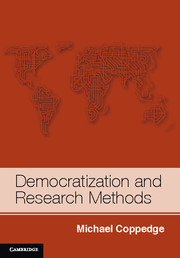Book contents
- Frontmatter
- Contents
- List of tables
- List of figures
- Acknowledgments
- 1 Research methods and democratization
- 2 Defining and measuring democracy
- 3 Criteria for evaluating causal theories
- 4 Checklists, frameworks, and Boolean analysis
- 5 Case studies and comparative history
- 6 Formal models and theories
- 7 Rigor in extensive and intensive testing
- 8 Political culture and survey research
- 9 Quantitative testing
- 10 An agenda for future research
- References
- Index
2 - Defining and measuring democracy
Published online by Cambridge University Press: 05 July 2012
- Frontmatter
- Contents
- List of tables
- List of figures
- Acknowledgments
- 1 Research methods and democratization
- 2 Defining and measuring democracy
- 3 Criteria for evaluating causal theories
- 4 Checklists, frameworks, and Boolean analysis
- 5 Case studies and comparative history
- 6 Formal models and theories
- 7 Rigor in extensive and intensive testing
- 8 Political culture and survey research
- 9 Quantitative testing
- 10 An agenda for future research
- References
- Index
Summary
Scholars who set out to study a political phenomenon talk past one another if they define the phenomenon differently. Suppose two scholars want to understand “democracy,” but one understands “democracy” to refer to the liberal political democracies of advanced capitalist economies, whereas the other considers only the “people's democracies” of communist regimes to be truly democratic. They will end up studying completely different countries and will probably come to opposite conclusions. If they try to reconcile their findings, they will discover that they are not really studying the same phenomenon at all. In practice, the difference in definitions is rarely so stark, but clear and consistent conceptualization is essential for preventing misunderstandings.
Unfortunately, one of the most difficult challenges in studying democratization has been reaching agreement on what “democracy” is. In fact, W. B. Gallie once argued that democracy is one of the best examples of an “essentially contested” concept: a concept that is the focus of endless disputes that, “although not resolvable by argument of any kind, are nevertheless sustained by perfectly respectable arguments and evidence” (Gallie 1956). Democracy is a contested concept because nearly everyone values the label, but there are different reasonable and legitimate, yet incompatible, criteria for judging whether the label is deserved.
- Type
- Chapter
- Information
- Democratization and Research Methods , pp. 11 - 48Publisher: Cambridge University PressPrint publication year: 2012
- 2
- Cited by



